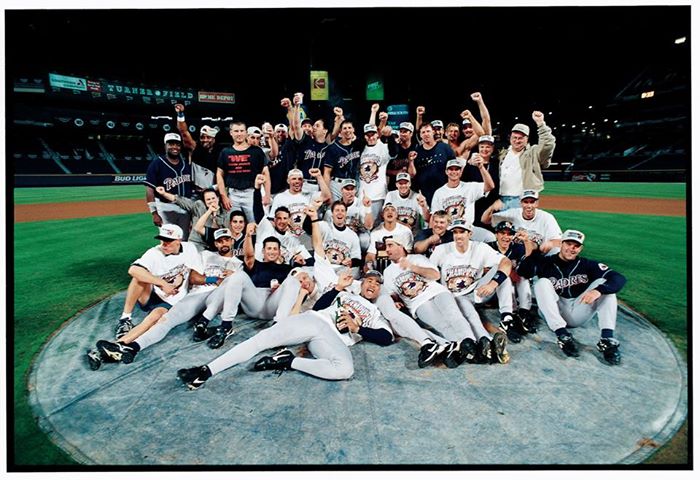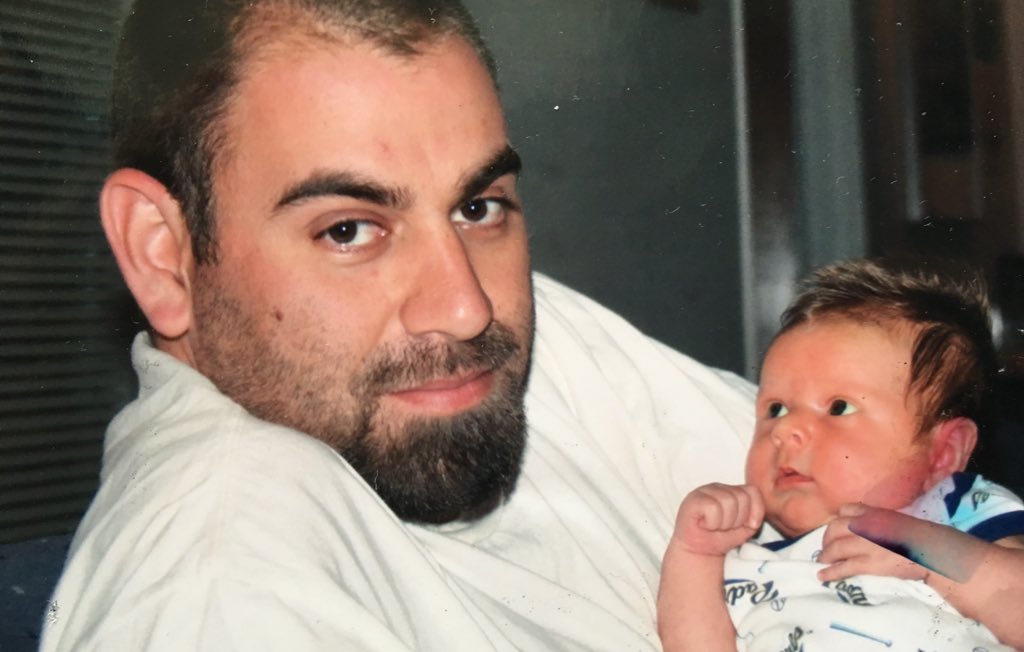Conjuring Up a Padres’ Season Like ’84 & ’98 with Kurt Bevacqua & Mark Sweeney

Credit: AP Photo

It is no secret that the San Diego Padres baseball franchise has always lacked an identity.
The team has constantly searched for a style that fits the city and its fan base – a type of play from the players on the field that the city of San Diego and its residents can get behind. In 1984 and 1998, the Padres got a brief glimpse of how special this fan base can be if they are motivated. Jack Murphy Stadium/Qualcomm Stadium was an absolute zoo during those playoff years. Nobody can debate the fans are here, they are just in a deep slumber.
The one thing I can put my finger on when comparing those two teams was hustle and desire. Both squads were not star-studded by any means. They instead relied on the fact they simply did not want to lose, and they had fun. Tony Gwynn was truly at the heart of both teams. Gwynn was one of the best players in the game of baseball, and an even better man. However he was not one to call out a player for lack of hustle. Instead, players like Steve Garvey and Graig Nettles would do that in 1984, and the intimidating Ken Caminiti had no problem calling out a player on any team he played on. He was intense and his emotions were worn on his sleeve.
There is a fine line between creating a successful team, and not. No matter what baseball analytical people think, chemistry is definitely needed to win games consistently. These two teams enjoyed the company of each other and played together like a family. Of course winning creates this feeling, but you can argue these two teams had it before Opening Day even hit. My attempt in this piece is to find out what made these two teams successful. What was it about these two squads that made them tick? Hopefully this spirit can be re-created in the future to bring a long-awaited championship to San Diego.
In writing this, I contacted Mark Sweeney of the 1998 Padres team and Kurt Bevacqua of the 1984 team. Both players were key members off the bench for their respective teams. Each player witnessed firsthand what it took for their team to win. They each experienced a winning culture with a Padres team, and that certainly is a rare thing. I am fascinated by what it took for each team to succeed. Each player graciously spoke to me, and here is what I learned from the two men. It’s really quite interesting.
In speaking to Mark Sweeney, we first discussed the locker room and what it took to keep it in order. He told me that it was a group of veterans that lead the team. He mentioned Wally Joyner, Greg Vaughn, and Ken Caminiti in particular. The 1998 Padres team was full of veteran-type players, and within that group they pretty much policed themselves. There were instances where a particular player stepped up though. I can remember the famous story of how one day, Tim Worrell came to the ballpark after being critical of Bruce Bochy in the local media. He could not find his stuff initially, but found his equipment in the manager’s office. When he went to retrieve it, Ken Caminiti was standing in the doorway and said “you want to manage the team, then this is where you dress”. Classic Caminiti, and point taken. Worrell no longer was critical of his manager and let Bochy do his job.

The 1998 team started out on fire, going 19-7 in the month of April. Mark told me that hot start helped develop chemistry quickly. Not that the team had issues prior to the month of April. He told me that in spring training, the team really began to come together. The players enjoyed playing games with each other and the bus rides and such between cities really cultivated the team’s chemistry. He spoke about how those early experiences created a winning culture with the team. That is what carried the team into April and that is what made them successful.
Creating this chemistry is no easy thing. The old saying that it takes one bad apple to ruin the whole bunch is very apparent in the locker room. You do not have to like every player on your team, but you do need to respect them. You must have the feeling that no matter what, you would go to war with anyone on your 25-man roster.
Baseball is the ultimate team sport. 162 games make up a season and there are tons of opportunities to get sidetracked. I asked Mark about Kevin Brown and his effect on the pitching staff and team. He and Brown were pretty close and Mark tells me that the pitcher was an important part of the team’s success. Even when Brown was not in a game pitching, he was on the bench yelling at umpires and helping his teammates get prepared. The squad took notice of that and he quickly gained the respect of the whole team, especially the hitters who were used to pitchers being there in body but not in spirit. Kevin Brown truly did not like to lose, and that rubbed off on the team and pitching staff.
The coaching staff was discussed next as we tried to determine what made the team so good. Mark mentioned each one of his coaches and indicated each brought something different to the table. He mentioned Dave Stewart and his attitude, and Tim Flannery for his fearlessness. Flannery in particular was a very emotional person and the team fed off of him. Being a former undersized ballplayer in the league gave him instant credibility. He was revered among the players and loved by the fan base. Bruce Bochy was the leader of the coaching staff and he had an outstanding knowledge of how to talk to his players and utilize them correctly. Not just in a correct manner, but in a manner that they would be productive.
In speaking to Kurt Bevacqua, we also talked a lot about Bruce Bochy. He told me that Bruce, among others on that 1984 team, paid attention the whole game. The bench players on that squad were constantly trying to steal the others team’s signs, or cheering their teammates on. No matter what the score was, or where they were in the standings, the team was “in” every game. Kurt could tell then that Bochy had the makings for a great manager as he was constantly looking for the edge against his opponent. The demeanor and candor of Bruce Bochy also dictated that he knew how to motivate. He learned it from a master motivator who was key to that 1984 playoff run.

Manager Dick Williams knew how to get the best out of his players. We extensively talked about this man, who Kurt described as a “motivator in retrospect”. He constantly ticked off players, by Kurt’s estimation, but at the same time those players performed better after feeling the fire from the manager. At the time, Bevacqua didn’t appreciate his managerial style, but looking back, he calls him a genius. Certain players need to be coddled while others need to be challenged. Williams had no problem challenging the mostly veteran group, and more often than not somebody was made angry. Kurt told me about the time Williams had contributed to an article that appeared in the local paper critiquing pitcher Andy Hawkins. It is no coincidence that right after the article was published Hawkins went on a run of pitching really well. Despite doing these things to motivate his team, the chemistry of this family type ball club was unaltered.
Chemistry is a difficult thing to re-create. That 1984 team came together in the spring, and by Kurt’s view, would do anything for each other. The whole 25-man squad was like a family and that was never more evident than that August afternoon in Atlanta when the team brawled with the Braves. We spoke about that game and Kurt told me that players you wouldn’t think of as being aggressive were in the middle of it. That really helped the whole squad come together. Not that the team needed help, but it fully solidified the fact the team was a family.
In speaking about the modern-day Padres, both men agree that the team is headed in the right direction. The youth movement with the draft, international market, and with trades, has created a fantastic farm system that should be extremely exciting in the near future. Sweeney indicated that Wil Myers is certainly someone to build around and his style of play is perfect for what the club wishes to teach. Myers is constantly hustling around the field and he plays any and every position he is asked. There is not one word of negativity from him, no matter the situation. He understands how precious his time in the major leagues is and Wil Myers will never be a player that takes it for granted. He is a ball player in every sense of the word.
Kurt Bevacqua and I discussed the play of the team of late and we both agree that Ron Fowler’s comments have struck a nerve within the team. Ironically, a sense of accountability has taken over and, with that, the team played more consistent down the stretch in 2017. We both feel these comments motivated the players in the fact they wanted to show the owner and the fans they do care. Some on the team have bought in to this new system, this new sense of accountability with your play. Those that have not will be weeded out, and only players that fit the profile will be kept moving forward. This will only benefit the team as they look to become more stable.
Both Mark Sweeney and Kurt Bevacqua were bench players on these championship teams. Both had 15-year careers and both performed in the playoffs; Bevacqua 7-19 (.368) and Sweeney 5-14 (.357). These men witnessed the Padres greatest first hand and it is no coincidence that both men still work in and around the city in some regard. Both Kurt and Mark agree the team needs to embrace its history and build within that. Slowly, the team is doing just that. The Padres’ Hall-Of-Fame at Petco Park is a wonderful spot. You all should check it out and get a sense of this franchise’s tradition.
To conjure up the spirits of these two championship teams is difficult, to say the least. The Padres are certainly on the correct path. Mark Sweeney and Kurt Bevacqua are baseball men. They have been around the game virtually their whole lives. They can feel the difference in the new ownership and their intentions. Clearly, the team’s frustrations of the past are behind them and the future looks incredibly bright. It may take a while, but this team should have sustained success for an extended period of time.

James was born and raised in America’s Finest City. He is a passionate baseball fan with even more passion towards his hometown Padres. James has written about the Padres and their prospects for over a decade. He also writes about San Diego State as well as other local sports. James is the Editor-In-Chief of EastVillageTimes.com. Always striving to bring you the highest quality in San Diego Sports News. Original content, with original ideas, that’s our motto. Enjoy.